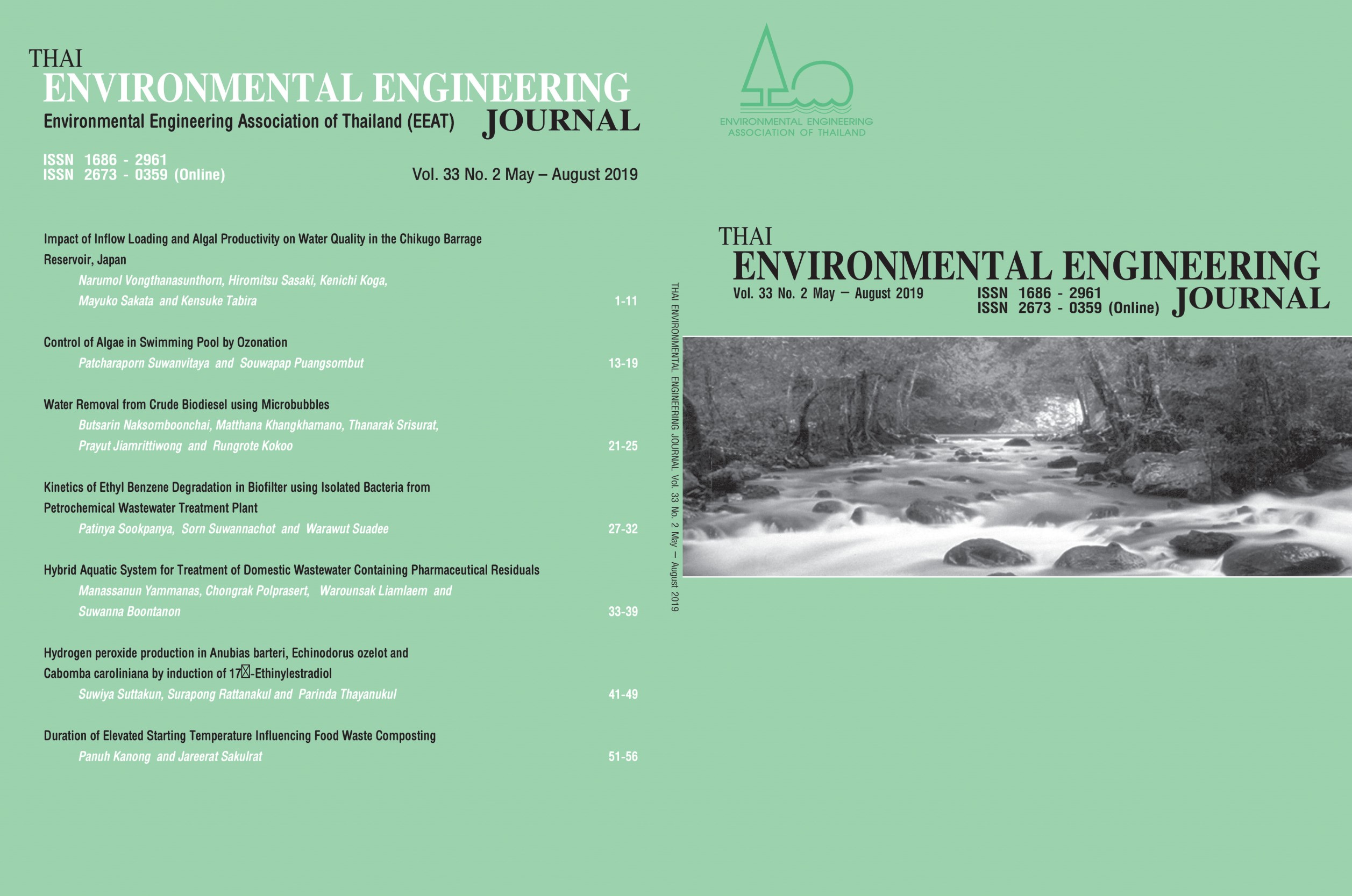Control of Algae in Swimming Pool by Ozonation
Main Article Content
Abstract
Algae proliferation is an important problem of swimming pool, making it unsightly and ultimately unacceptable to swimmers. Chlorination of the pool seems to inhibit growth of microorganism. However some types of algae can survive the condition and are frequently found (attached on tiles or in suspension). In this study algae samples were collected from a hotel swimming pool and cultured in Bold’s Basal medium. Morphological identification by Direct Microscopic Examination of the culture showed that predominating algae were Oscillatoria, Scenedesmus, Euglena and Phagus. Algae in the culturing bottles were found in 3 zones namely attached on the wall (A), suspended (SS) and settled at the bottom (ST). Ozonation of algae culture with 22.1-141.5 mgO3/L (5-30 min.ozonation time) was found to remove attached and suspended algae. These then settled down to the bottom resulting in an increase in the settled portion. It was noted that ozone consumption of the suspended portion (1.72 mgO3/mgAlgae at 30 min.) was higher than that of the attached portion (0.47 mgO3/mgAlgae at 30 min.) indicating that the former was more resistant to ozone than the latter. In terms of algae type, of the 4 predominating spcies, Euglena sp. was the most resistant
Article Details
References
[2] Mahakhant, A., Chalermsiri, W., Kunyalung, W., Tungtananuwat, M. and Arunpairojana V. 2001. Survey and collection of freshwater microalgae strain in Bangkok and Vicinity. Microbiological Resources Centre (MIRCEN), Thailand Institute of Scientific and Technological Research (TISTR).
[3] Wongrat, L., Wongrat, P., Ruangsomboon, S. 2001. Diversity of freshwater phytoplankton in Thailand (Chlorophyta and Chromophyta). Department of Fishery Biology. Faculty of Fisheries, Kasetsart University, Bangkok.
[4] Lueangthuwapranit, C., Sampantarak, U. and Wongsai, S. 2011. Distribution and abundance of phytoplankton: Influence of salinity and turbidity gradients in the Na Thap River, Songkhla province, Thailand. Journal of Coastal Research 2011; 27 (3): 585 – 594.
[5] Suwanvitaya, P., Suwan, S. Predominant algae in Bang Phra Reservoir: morphological and molecular identification. In: the 9th International Symposium on Lowland Technology, Saga University, Japan, 2014; 646-651.
[6] Shen, Q., Zhu, J., Chen, L., Zhang, J., Zhang, Z. and Xu, X. 2011. Enhanced algae removal by drinking water treatment of chlorination coupled with coagulation. Desalination 27(1): 236-240.
[7] Kim, J.G., Yousef, A.E. and Khadre, M.A. 2003. Ozone and its current and future application in the food industry. Advances in Food and Nutrition Research; 45: 167–218.
[8] Pandiselvam, R., Shajahan, S., Ramarathinam, M., Kothakota, A. and Hebbar, K. 2017. Application and kinetics of ozone in food preservation. Ozone Science and Engineering. 39(2): 115-126.
[9] Cho, M., Kim, J., Kim, J.Y., Yoon, J. and Kim, J.H. 2010. Mechanisms of Escherichia coli inactivation by several disinfectants. Water Research; 44: 3410-3418.
[10] Kaewdam,J. and Suwanvitaya, P. Ozone disinfection of domestic wastewater. In: the 15th National Conference on Environmental Engineering, Environmental Engineering Association of Thailand, 2016; 57-58.
[11] Suwanvitaya, P. and Singhaphen, S. 2018. Ozonation as Cyanophyta Control Method for Water Treatment. Engineering and Applied Science Research. 45(3): 235-239.
[12] Bold, H.C. and Wynne, M.J. 1978. Introduction to the Algae. Prentice-Hall of India, New Delhi.
[13] Rakness , K., Gordon, G., Langlais, B., Masschelein, W.M. et al. 1996. Guideline for measurement of ozone concentration in the process gas from an ozone generator. Ozone Science and Engineering. 18: 209-229.
[14] APHA, AWWA and WEF. 2012. Standard Methods for Examination of Water and Wastewater. American Public Health Association. Washington, D.C.


